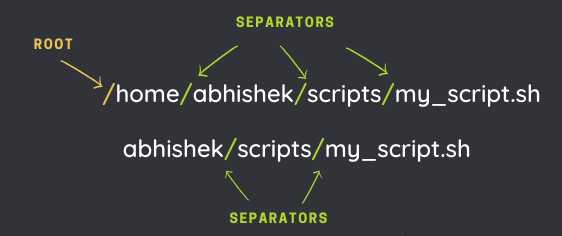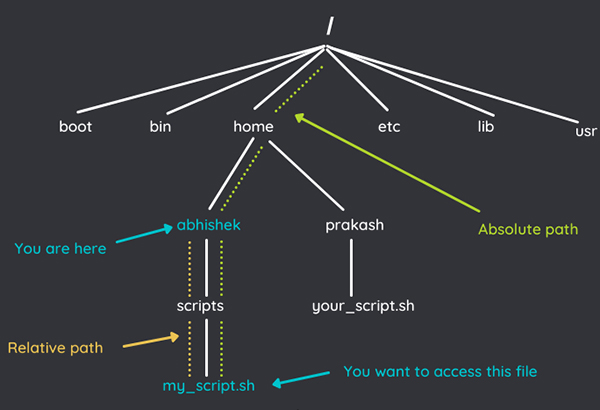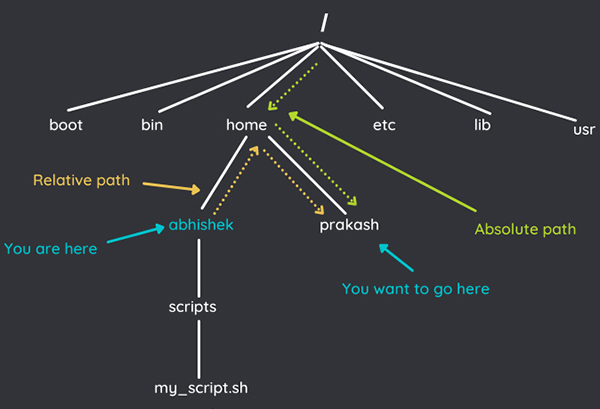
Path is one of the most basic concepts in Linux, which every Linux user must know.
Path is one of the most basic concepts in Linux, which every Linux user must know.
Path refers to the way files and directories are referenced. It gives the location of a file or directory in the Linux directory structure, consisting of the name followed by a slash.
/home/abhishek/scripts
As a system user, you use a path when you want to access a file or directory, or when you must specify the location of a file or directory for a command or script.
cat /home/abhishek/scripts/my_script.sh
Remember that if the path starts with a slash "/", the first slash represents the root and the remaining slashes in the path are just separators. Beginners often confuse the root slash and the delimiter slash. 
In the picture above, the first path starts with the root path (/) and the second path does not start with /. Both of these ways of writing are correct, the first is an absolute path and the second is a relative path.
Absolute paths and relative paths in Linux
Absolute paths always start from the root directory (/), such as:
/home/abhishek/scripts/my_scripts.sh
Relative paths start from the current directory. For example, if you are in the /home directory and want to access the my_script.sh file, the access path should be:
abhishek/scripts/my_scripts.sh
Understand the difference between absolute paths and relative paths
We all know that the directory structure in Linux is a tree, starting from the root (/) and then generating branches.
Assume that we are now in the directory abhishek and want to access the file my_scripts.sh, as shown in the following figure showing the two paths:

Suppose we use the ls command to view the file information of my_script.sh, then use the absolute path:
ls -l /home/abhishek/scripts/my_script.sh
Then, relative path:
ls -l scripts/my_script.sh
Then, except for the different file paths, the above two methods are exactly the same:

Note: In Linux, file names are case-sensitive. Can have uppercase, lowercase, numbers, dots, dashes, underlines, and most characters except slash (/). The slash (/) is a reserved character used in root directories and used to separate directories in a path.
Use relative paths with . and .. directories
There are two special relative paths:
. (a dot): indicates the current path in the path;
.. (two dots): indicates the parent directory, that is, the upper-level directory.
As shown below, we need to go from the abhishek directory to the prakash directory.

To switch directories, use the cd command. If you use an absolute path, you can do this:
cd /home/prakash
If you use a relative path, you need to use a special relative path.. :
cd ../prakash
Why use ..? Since the relative path starts from the current directory, we need to tell the cd command to go up one level, taking us to the /home directory and from there into the prakash directory.
Absolute paths always start with / and are independent of the current location; relative paths depend on the current location.
Absolute path or relative path, which one should be used?
Honestly, there is no straightforward answer to this question. It depends.
If the directory hierarchy you are currently in is relatively deep and you need to move up or down one level, it is easier to use relative paths.
Assuming you are located in
/home/username/programming/project/interface/src/header directory, and needs to access something in the /home/username/programming/project/interface/bin directory. Using a relative path avoids typing all that lengthy directory name, just use .././bin here.
However, if you want to access something in the /usr/bin directory from the /home/username/programming/project/interface/src/header directory, then use ../../../../ ../../usr/bin will be more troublesome. In this case, it is more convenient to use the absolute path.
Another situation is to use the path in a script or program. If the location is certain, use an absolute path; if you have multiple folders in the project and need to switch between them, use a relative path here because you are not sure where the end user will put the program. .
The above is the detailed content of The most basic knowledge: absolute paths and relative paths in Linux. For more information, please follow other related articles on the PHP Chinese website!




